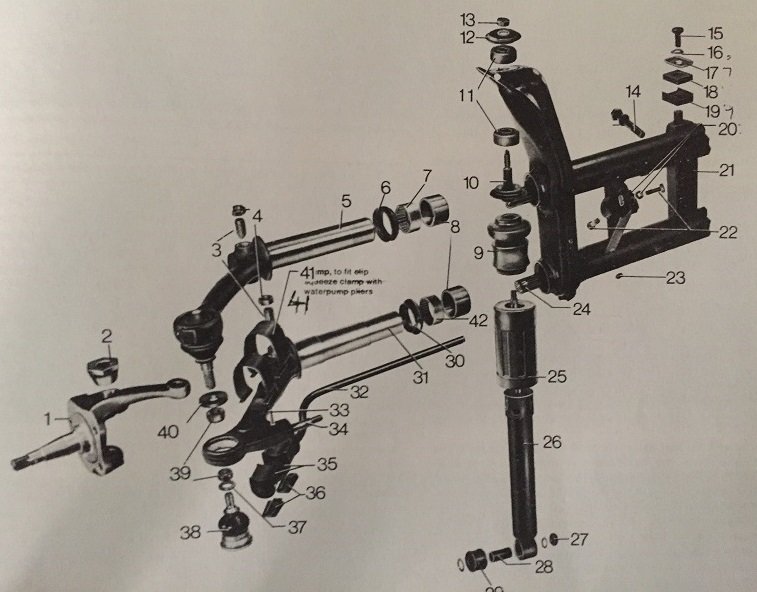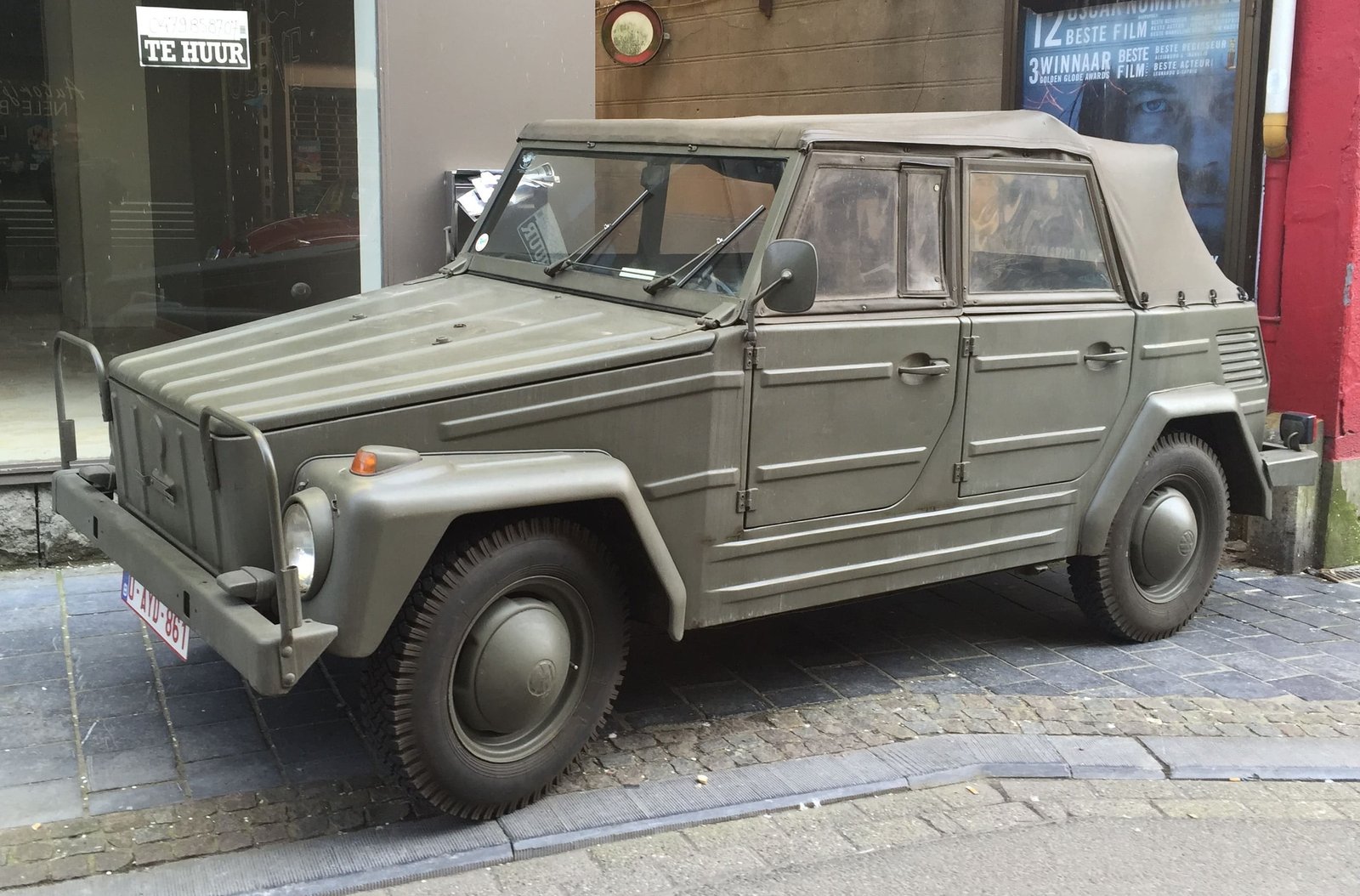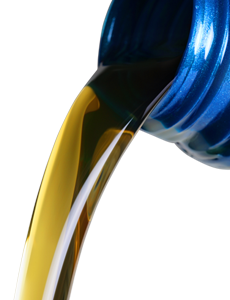TECHNICAL INFORMATION PAGE
- Posted by: Kate McCarthy Bedward
- August 19, 2016
- Contact Page,
We get many questions each day beginning often with the words 'How do I...' - so we figured we'd start sharing answers for the benefit of all our visitors and
Classic Volks supporters.
How do I contribute an article? Posted: March 19,2016 | Kate McCarthy Bedward
Glad you ask! We are always on the look out for informative and well written blogs or 'write-ups' (especially those with images).
If you've spent time documenting a particular VW related restoration task (or project etc) and wish to share it with others - we would
like to help. Get in touch via our classic volks contact page and let's find out if you can help us help others.
How do I find the VW VIN?
VW Vehicle Identification
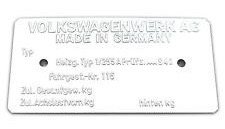
There are three places the vw identification can be found. In 1967, the VIN is a 9 digit number beginning with 117. The 11 indicates type 1 chassis and the 7 indicates model year. The last 6 digits are a serial # in order of production.
Under the back seat, stamped into the metal of the frame tunnel. This is the one that is recognized by the DMV.
In the spare tire well, you might find an aluminum plate that is rivited to the body. If the body is original to the chassis, the number here will match the one on the tunnel. This tag often includes other info, like original color code, a factory option code (M code) and original engine #.
A third place you can fin the VIN is inside the driver's side door frame. A small aluminum tag with the last 6 digits was rivited or screwed on the forward portion of the body surrounding the door.
Often the tags in the spare well and the door frame are lost to repaint jobs or body work.
Source: karl_68coupe/30+ years owner/restorer
Is your Fan belt okay?
Check your Fan Belt tension
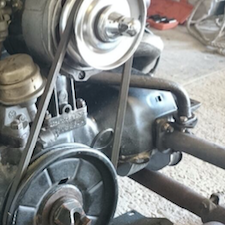
Your aircooled VW
fan belt should be checked often to ensure that it is at a 'correct' tension. But what is 'correct' I guess you're thinking. While many of our more experienced
dubbers will already have an understanding of 'correct', we appreciate that those new to their aircooled engine will need a more hands-on tutorial so we'll do our best to advise you on what to look out for. Start then with the engine switched off, then
open the engine lid and use one hand to grasp and pinch together both sides of the fan belt. It should give 'a little' but by no means be easy to pinch together.
If you're local to York, get in touch with us and we'll help to properly check not only the tension, but the quality of your current fan belt,
or put you in touch with experienced VW owners who can advise you. Need a
replacement fan belt?
Do you know your aircooled engine?
VW Engine Basics

There are many new Aircooled VW owners out there, and even a few who have had one for years, who spend very little time actually working on
and getting familiar with their Volkswagen engine. As part of our
Field of Dreams Aircooled VW show, we
spend a little time going over the basics to more intricate aspects of the standard aircooled vw engine. If you are new to the aircooled engine,
there are a few things that we feel you really need to be familiar with; for your motoring pleasure, and financial saving.
Aircooled terminology
Dynamo, Coil
There is no escaping it, if you own an aircooled Volkswagen you are going to need to get to grips with a range of commonly used jargon
relating to the engine, body and vehicle itself. Above we've listed a few of the more popular ones that bring a quizical look to the faces of many
new to aircooled ownership. Let's now cover those and many others in greater detail.
Dynamo - As you stand facing the engine,
this is the topmost, smaller of the two circular objects which the fan belt encompasses. Aircooled engines use a 'dynamo'
or an 'alternator', same location, to generate the electric power for the car and charge the battery.
Coil - (see image below) helps to keep the car engine running by
transforming the low voltage in the battery into the greater volts necessary to provide and create an electrical spark in the spark plugs which
then ignite the car's fuel.
Aircooled VW Beetle/VW Campervan/ VW Ghia won't start?
- Aircooled VW, VW Type1, Classic VW
- Volkswagen: 1968 - 1983, starting problems
- 8,144 Views
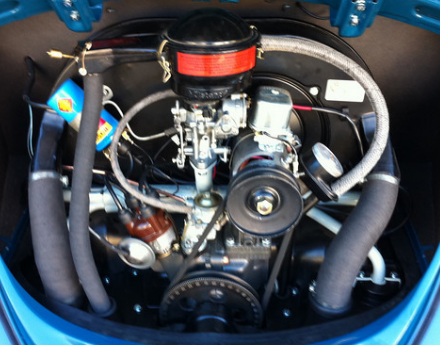 So a break down earlier today (Sunday 21 August 2016) prompted another write up; this time on startup problems with an Aircooled
Volkswagen. Let's start with the more traditional scenario, that of getting to your VW for the first start up after it being sat for say, a week or so.
The questions we would ask are: Does the engine turn over but won't 'fireup/start'? Is it turning very slowly or at an expected speed?
Are the lights on the instrumental panel on/showing or not? and let's not overlook the
seemingly obvious, Is there enough petrol in the tank?
So a break down earlier today (Sunday 21 August 2016) prompted another write up; this time on startup problems with an Aircooled
Volkswagen. Let's start with the more traditional scenario, that of getting to your VW for the first start up after it being sat for say, a week or so.
The questions we would ask are: Does the engine turn over but won't 'fireup/start'? Is it turning very slowly or at an expected speed?
Are the lights on the instrumental panel on/showing or not? and let's not overlook the
seemingly obvious, Is there enough petrol in the tank?
A rule when trouble-shooting problems is to start with the basics, then work
towards the more complicated possibilities (in this case, turning it off & on again isn't an option) - so first check to see that
the necessary basic connections are secure i.e. The battery (charged and working) terminals are clean and securely fastened - check that the connections aren't loose or corroded. A fully-charged battery should read about 12.5V; at any reading lower than
about 10V the starter motor will not turn over or will do so very weakly and the plugs will probably not 'fire'.
The grounding straps may be corroded/loose/broken.Check the wires
running from the coil are all attached; The large center wire from the coil
goes to the distributor cap and from the distributor, the other leads will run to the spark plugs.
There are two terminals/sides on the coil, one of these terminals is the negative (-) terminal, (governed by fuse #1). If you can't make out the signs on it, try looking for a wire (usually green but maybe you've had re-wire work) running
from the coil (negative side) to the distributor. The other termimal/side on the coil is the positive (+) one, (#15).
The incoming power wire from the ignition is attached to this terminal, as well as wires to
several other items which need power, like the idle cutoff valve, the automatic choke,
and the backup lights. *In VW electrical world, black insulation is typically for power.
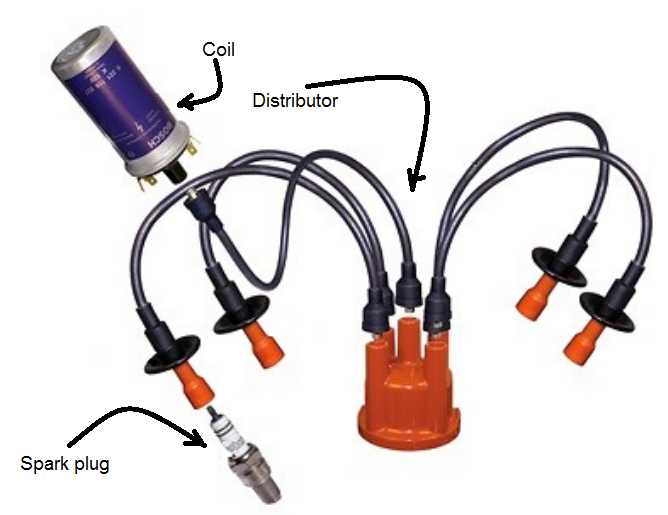 Make sure that all the leads on the distributor are properly connected; the one running
to the coil and the others running to the spark plugs and properly seated to the spark plugs. If you turn the key and the lights come on
but no engine rotation, the starter motor doesn't seem to turn maybe all you get is a 'Click Clunk' the starter motor and or
the starter solenoid may be faulty. Sounds odd I know, but trying giving the starter motor a whack (don't be shy) with a hammer. It could be that the
solenoid is sticking and this action will often jolt it loose. Remember: It's tricky to try to fully cover every angle here, so Find us on Facebook or drop us an email and we'll help or get you help.
Make sure that all the leads on the distributor are properly connected; the one running
to the coil and the others running to the spark plugs and properly seated to the spark plugs. If you turn the key and the lights come on
but no engine rotation, the starter motor doesn't seem to turn maybe all you get is a 'Click Clunk' the starter motor and or
the starter solenoid may be faulty. Sounds odd I know, but trying giving the starter motor a whack (don't be shy) with a hammer. It could be that the
solenoid is sticking and this action will often jolt it loose. Remember: It's tricky to try to fully cover every angle here, so Find us on Facebook or drop us an email and we'll help or get you help.
So what about if the engine is spinning/rotating but it will not start then this is mostly likely because the engine is
not receiving fuel and or spark at the necessary point of ignition in the cylinders. This bit gets tricky so again we'll keep it
limited to general terms, and ask that you get in touch for more specific diagnostics but the first areas that spring to mind are: Checking
the spark plugs to ensure they aren't worn out, wrongly gapped (so too wide or closed, try a 0.60mm), try doing a 'static timing' (covered elsewhere) to see if the timing is incorrect.
and possibly the coil is faulty or the ignition wiring is faulty. Not to forget the prompt for this write up - check for a blown fuse. While driving earlier, the engine cut out
and after the sheepish push out of traffic I noticed that the instrument lights did not come on when I turned the key. This got me thinking about it being an electrical
fault versus a mechanical one, leading to a quick investigation and replacement of the blown fuse - replaced and back to driving pleasure.
How do I replace the Windscreen for a VW Trekker (Type 181/182)?
- VW Safari, Thing, Trekker, Kurierwagen
- Manufactured by Volkswagen: 1968 - 1983
- 1,564 Views
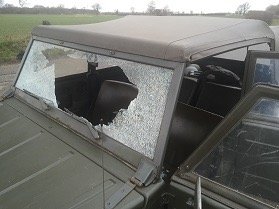 If you find
yourself in the situation in which I was (see image left) - don't worry, help is at hand. I was initially 'gutted', afterall, I love my
Trekker (a.k.a 'Major Marley'). My disappointment quickly turned to panic as shards of glass started falling, no flying in my direction.
If you find
yourself in the situation in which I was (see image left) - don't worry, help is at hand. I was initially 'gutted', afterall, I love my
Trekker (a.k.a 'Major Marley'). My disappointment quickly turned to panic as shards of glass started falling, no flying in my direction.
Unlike modern windscreens / windshields which are generally made of laminated safety glass, a type of treated glass, which consists of two (typically) curved
sheets of glass with a plastic layer laminated between them for safety, the Trekker windscreen is pretty much, well, just a tough piece of glass.
Replacing the windscreen is easier than you may think and having opted to bond further with my Trekker by doing the work myself, I next wanted to
share my experience.
First get a replacement windscreen - which saw me asking around on facebook, making enquiries in VW Trekker groups and then being faced with two options.
1. Be lucky enough to find and buy a Trekker Windscreen. Costly, (as with anything
Trekker related), but an option none-the-less. Buy the way, if you can't find one for your own replacement need,
be sure to email Classic Volks and they'll do their best I know to source one for you. Option 2. - Get one made. This isn't a recommendation remember,
I'm really only sharing my experience. I chose option 2 and for a for a few reasons. Mainly, it was a heck of a lot cheaper - afterall, it is
simply a flat bit of glass that we're talking about and but equally I recognised this as an opportunity to now have a safer windscreen (laminated). Yes it was tempting to keep the car in it's 'close to original' state,
but after a period of deliberation I opted for option 2. I should mention too that I resisted another temptation, that of having the glass tinted a light shade of green!
 If you decide
to buy a genuine Volkswagen Trekker windscreen (glass only) then good on you and pay no mind to this bit. To those who decide to get the VW Trekker replacement glass
made c/o a local Glazier - here are dimensions. By clicking on the image you are able to save or download it (right-click/ save-as) and take it
with you on your phone or print it off when required. I found a Glazier in York, gave him the print out of the dimensions and as mentioned earlier, had mine made.
If you decide
to buy a genuine Volkswagen Trekker windscreen (glass only) then good on you and pay no mind to this bit. To those who decide to get the VW Trekker replacement glass
made c/o a local Glazier - here are dimensions. By clicking on the image you are able to save or download it (right-click/ save-as) and take it
with you on your phone or print it off when required. I found a Glazier in York, gave him the print out of the dimensions and as mentioned earlier, had mine made.
Removing the currently broken windscreen was simply a matter of tapping the remaining glass out while carefully removing the rubber
seal from the windscreen frame. I took the time to tease out every bit of broken glass from the rubber seal before gearing up for the cold windy drive to
my nearest petrol-station to hoover up the bits of glass now lying inside the Trekker. On this note, is it just me or is there something incredibly satisfying to
hovering up bits of 'stuff'? It was so cool!! hundreds of bits, the sound..it was...eh hem, anyway, Trekker now feeling safer to drive, time for the next step.
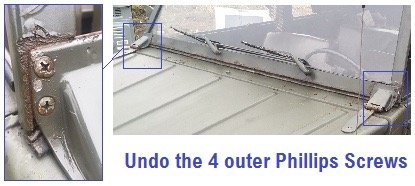 Now in possession of
a new windscreen glass, my next question was how do i replace the windscreen?. Having now done it for the first (hopefully only) time,
do you want the good news first? You don't need
to remove the wiper motor! You don't need to remove the rear-view mirror! All you need to do is undo the four large
Phillips screws on the front, outer, bottom right and left on the windscreen frame.
Now in possession of
a new windscreen glass, my next question was how do i replace the windscreen?. Having now done it for the first (hopefully only) time,
do you want the good news first? You don't need
to remove the wiper motor! You don't need to remove the rear-view mirror! All you need to do is undo the four large
Phillips screws on the front, outer, bottom right and left on the windscreen frame.
The bad news, well for me anyway, was, well you can see for yourself. The screws were pretty much rusted in place and I've got three bent-out-of-shape screwdrivers to show for my initial effort in getting them out.
Sure I soaked them first in lubricant and yes I used the correct fitting Phillips screwdriver - well, I did the thrid time. All the time what was worrying me most was snapping the screws.
Last thing I wanted was to compond the problem and need to drill the screws out etc. so I made a quick call, put my warmest 10 or so jackets on and drove 'Maj Marley' up
to my friends at Aircooled Addiction for them to help.
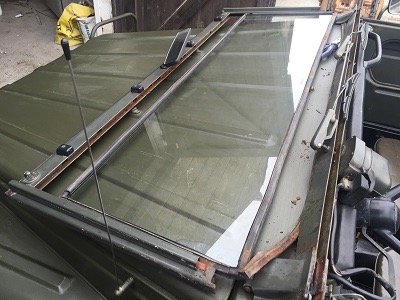 Solution that worked for me? Heat.
Warming the screws up worked a treat. Once the screws are out, the entire frame of the windscreen, lifts upwards and is now free from the lower portion of the frame. The remainding work
unfolds with logic.
Solution that worked for me? Heat.
Warming the screws up worked a treat. Once the screws are out, the entire frame of the windscreen, lifts upwards and is now free from the lower portion of the frame. The remainding work
unfolds with logic.
If the rubber seal which goes around the glass can be reused then fine. Otherwise replace with new ones and apply a bit of washing up liquid or grease to 'lube' the outter edges of the
rubber seal to help it back into the frame more easily. Before fully tightening the screws, once the replacement glass is in and the entire frame reattached, try the soft top and windows to check for a
snug fit. Other than that...YAY!
This definately fell into the 'easy when you know how' category. Hope this helps. Any questions - contact us at ClassicVolks by email or find us on facebook.
 There are three places the vw identification can be found. In 1967, the VIN is a 9 digit number beginning with 117. The 11 indicates type 1 chassis and the 7 indicates model year. The last 6 digits are a serial # in order of production.
Under the back seat, stamped into the metal of the frame tunnel. This is the one that is recognized by the DMV.
In the spare tire well, you might find an aluminum plate that is rivited to the body. If the body is original to the chassis, the number here will match the one on the tunnel. This tag often includes other info, like original color code, a factory option code (M code) and original engine #.
A third place you can fin the VIN is inside the driver's side door frame. A small aluminum tag with the last 6 digits was rivited or screwed on the forward portion of the body surrounding the door.
Often the tags in the spare well and the door frame are lost to repaint jobs or body work. Source: karl_68coupe/30+ years owner/restorer
There are three places the vw identification can be found. In 1967, the VIN is a 9 digit number beginning with 117. The 11 indicates type 1 chassis and the 7 indicates model year. The last 6 digits are a serial # in order of production.
Under the back seat, stamped into the metal of the frame tunnel. This is the one that is recognized by the DMV.
In the spare tire well, you might find an aluminum plate that is rivited to the body. If the body is original to the chassis, the number here will match the one on the tunnel. This tag often includes other info, like original color code, a factory option code (M code) and original engine #.
A third place you can fin the VIN is inside the driver's side door frame. A small aluminum tag with the last 6 digits was rivited or screwed on the forward portion of the body surrounding the door.
Often the tags in the spare well and the door frame are lost to repaint jobs or body work. Source: karl_68coupe/30+ years owner/restorer Your aircooled VW
fan belt should be checked often to ensure that it is at a 'correct' tension. But what is 'correct' I guess you're thinking. While many of our more experienced
dubbers will already have an understanding of 'correct', we appreciate that those new to their aircooled engine will need a more hands-on tutorial so we'll do our best to advise you on what to look out for. Start then with the engine switched off, then
open the engine lid and use one hand to grasp and pinch together both sides of the fan belt. It should give 'a little' but by no means be easy to pinch together.
If you're local to York, get in touch with us and we'll help to properly check not only the tension, but the quality of your current fan belt,
or put you in touch with experienced VW owners who can advise you. Need a replacement fan belt?
Your aircooled VW
fan belt should be checked often to ensure that it is at a 'correct' tension. But what is 'correct' I guess you're thinking. While many of our more experienced
dubbers will already have an understanding of 'correct', we appreciate that those new to their aircooled engine will need a more hands-on tutorial so we'll do our best to advise you on what to look out for. Start then with the engine switched off, then
open the engine lid and use one hand to grasp and pinch together both sides of the fan belt. It should give 'a little' but by no means be easy to pinch together.
If you're local to York, get in touch with us and we'll help to properly check not only the tension, but the quality of your current fan belt,
or put you in touch with experienced VW owners who can advise you. Need a replacement fan belt? There are many new Aircooled VW owners out there, and even a few who have had one for years, who spend very little time actually working on
and getting familiar with their Volkswagen engine. As part of our Field of Dreams Aircooled VW show, we
spend a little time going over the basics to more intricate aspects of the standard aircooled vw engine. If you are new to the aircooled engine,
there are a few things that we feel you really need to be familiar with; for your motoring pleasure, and financial saving.
There are many new Aircooled VW owners out there, and even a few who have had one for years, who spend very little time actually working on
and getting familiar with their Volkswagen engine. As part of our Field of Dreams Aircooled VW show, we
spend a little time going over the basics to more intricate aspects of the standard aircooled vw engine. If you are new to the aircooled engine,
there are a few things that we feel you really need to be familiar with; for your motoring pleasure, and financial saving.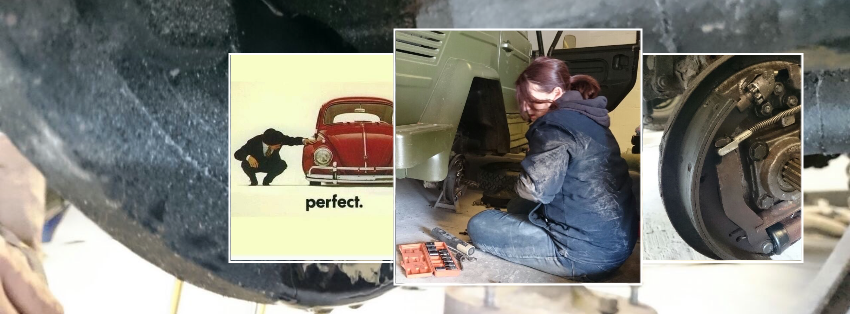
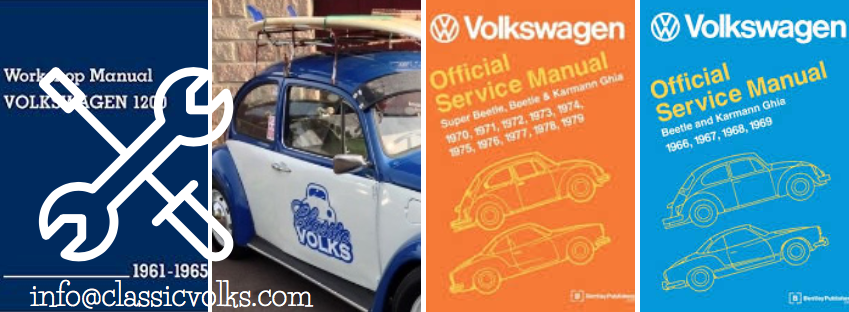
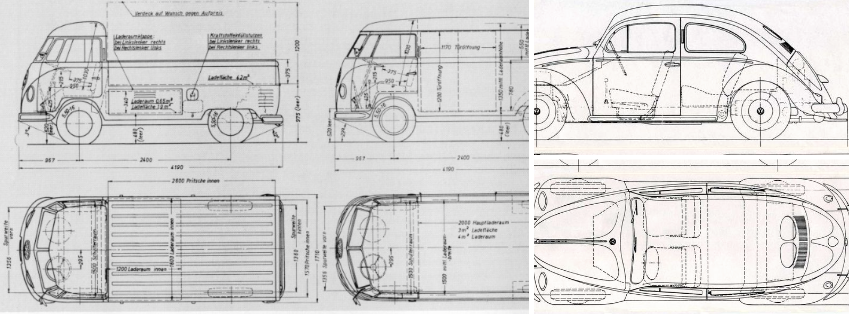
 Make sure that all the leads on the distributor are properly connected; the one running
to the coil and the others running to the spark plugs and properly seated to the spark plugs. If you turn the key and the lights come on
but no engine rotation, the starter motor doesn't seem to turn maybe all you get is a 'Click Clunk' the starter motor and or
the starter solenoid may be faulty. Sounds odd I know, but trying giving the starter motor a whack (don't be shy) with a hammer. It could be that the
solenoid is sticking and this action will often jolt it loose. Remember: It's tricky to try to fully cover every angle here, so Find us on Facebook or drop us an email and we'll help or get you help.
Make sure that all the leads on the distributor are properly connected; the one running
to the coil and the others running to the spark plugs and properly seated to the spark plugs. If you turn the key and the lights come on
but no engine rotation, the starter motor doesn't seem to turn maybe all you get is a 'Click Clunk' the starter motor and or
the starter solenoid may be faulty. Sounds odd I know, but trying giving the starter motor a whack (don't be shy) with a hammer. It could be that the
solenoid is sticking and this action will often jolt it loose. Remember: It's tricky to try to fully cover every angle here, so Find us on Facebook or drop us an email and we'll help or get you help.
 If you find
yourself in the situation in which I was (see image left) - don't worry, help is at hand. I was initially 'gutted', afterall, I love my
Trekker (a.k.a 'Major Marley'). My disappointment quickly turned to panic as shards of glass started falling, no flying in my direction.
If you find
yourself in the situation in which I was (see image left) - don't worry, help is at hand. I was initially 'gutted', afterall, I love my
Trekker (a.k.a 'Major Marley'). My disappointment quickly turned to panic as shards of glass started falling, no flying in my direction.
 Now in possession of
a new windscreen glass, my next question was how do i replace the windscreen?. Having now done it for the first (hopefully only) time,
do you want the good news first? You don't need
to remove the wiper motor! You don't need to remove the rear-view mirror! All you need to do is undo the four large
Phillips screws on the front, outer, bottom right and left on the windscreen frame.
Now in possession of
a new windscreen glass, my next question was how do i replace the windscreen?. Having now done it for the first (hopefully only) time,
do you want the good news first? You don't need
to remove the wiper motor! You don't need to remove the rear-view mirror! All you need to do is undo the four large
Phillips screws on the front, outer, bottom right and left on the windscreen frame. Solution that worked for me? Heat.
Warming the screws up worked a treat. Once the screws are out, the entire frame of the windscreen, lifts upwards and is now free from the lower portion of the frame. The remainding work
unfolds with logic.
Solution that worked for me? Heat.
Warming the screws up worked a treat. Once the screws are out, the entire frame of the windscreen, lifts upwards and is now free from the lower portion of the frame. The remainding work
unfolds with logic. 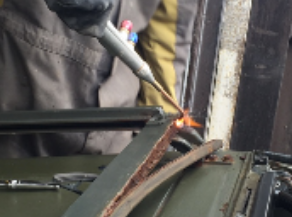 There are a number
of options for getting rusty screws out. Do a bit of research and use the option that works. It can take a few hours either way depending on just how
set in rust the particular screw (or nut) is.
There are a number
of options for getting rusty screws out. Do a bit of research and use the option that works. It can take a few hours either way depending on just how
set in rust the particular screw (or nut) is.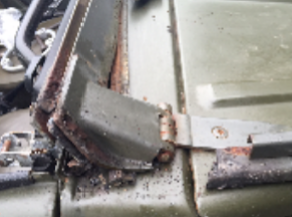 One of the
satisfying parts of this replacement task was gaining experience and knowledge. It's worth pointing out that this job is even easier
with a friend to help. This was particularly true when it cam time to get the screws back in.
One of the
satisfying parts of this replacement task was gaining experience and knowledge. It's worth pointing out that this job is even easier
with a friend to help. This was particularly true when it cam time to get the screws back in.